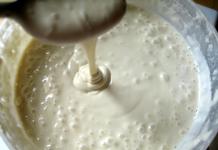At present, the problems of improving the condition of soils, possible ways to increase its biological activity, and to preserve and improve its fertility are acute in agriculture. An analysis of the literature shows that everywhere there is a change in the physicochemical properties, leading to the destruction of the soil structure, the violation of its water-air and organic composition. Among the main reasons for the decrease in humus in soils, one can name the increased mineralization of the organic components of the soil, due to intensive cultivation, the use of mineral fertilizers and pesticides.
In the case of fruit trees, the flowering and fruit formation phase is seriously affected. Another outstanding feature of copper deficiency in fruit trees is the arrest of apical growth in fertile branches. Toxicity in plants due to copper. The contribution of tailings from the mining industry, the indiscriminate use of fertilizers that provide copper, or even fungicides and pesticides based on this element, can lead to the inclusion a large number active copper into soil and plants, which can be toxic to plant growth and development.
What are pesticides?
Pesticides(from lat. pestis - infection and lat. caedo - kill) - chemicals used to combat harmful organisms. Pesticides are used primarily in agriculture, although they are also used to protect food supplies, timber and other natural products. Many countries use pesticides to chemically control forest pests and vectors of human and domestic animal diseases (such as malarial mosquitoes).
Detrimental impact
Pesticides are the only pollutant that is deliberately introduced by man into environment. In a number of branches of agriculture, pesticides are used in large quantities. Their annual application, often several times a season, leads to the accumulation of pesticides in the soil and its poisoning. Together with pesticides, compounds of iron, lead, mercury, and copper enter the soil. Entering the soil chemical compounds lead to a gradual change in the chemical and physical properties
soil, reduce the number of living organisms, worsen its fertility.
Pesticides are distributed over large areas, very remote from the places of their application. The use of broad-spectrum pesticides is fraught with the "revival" of pests, their appearance after processing in larger quantities. This is due to the fact that the drug kills not only pests, but also predators that destroy them.
A striking symptom caused by the toxicity of this element is intense chlorosis of old leaves, similar to that which causes iron deficiency, but in new leaves. In our country, pollution produced by copper tailings can cause toxicity problems in plants. However, in some studies conducted on vineyards growing in soils with a high content of this element, as a result of pollution by tailings, typical symptoms of toxicity reported in the literature were not observed.
List of sources used
However, a decrease in plant yield was observed. It is important to note that excess copper in the soil in some species does not appear at the leaf level, especially when it comes to large amounts, as this often damages the plant's root system, preventing it from being absorbed. In sandy soils, toxicity may occur more easily. Another negative effect of excess copper is its detrimental effect on soil microbial biomass.
Mineral fertilizers
What is mineral fertilizers?
Mineral fertilizers - inorganic compounds containing nutrients necessary for plants. Mineral fertilizers contain nutrients in the form of various mineral salts. Soils usually contain all the nutrients a plant needs. But often individual elements are not enough for satisfactory plant growth. On sandy soils, plants often lack magnesium, on peat soils - molybdenum, on chernozems - manganese, etc. The use of mineral fertilizers is one of the main methods of intensive farming. With the help of fertilizers, it is possible to dramatically increase the yields of any crops on already developed areas without additional costs for the cultivation of new lands.
Soil is one of the most complex natural resources on the planet. Two centimeters of soil take over a thousand years to form and, when healthy, can contain billions of microorganisms. Therefore, it is considered a non-renewable and irreplaceable resource for human life. Currently, 2.6 billion people are directly dependent on agriculture to survive, yet 52% of the area used for food crops is affected by degradation. Approaching the resource as a whole, pollution and degradation data indicate that 33% of the available land on the planet has already been degraded, an index considered alarming if we think about the future of next generations.
Detrimental impact
Soil pollution and disruption of the normal circulation of substances occurs as a result of improper use of mineral fertilizers. Together with manure and faeces, pathogenic bacteria, helminth eggs and other harmful organisms often enter the soil, which enter the human body through food. High doses of nitrogen fertilizers are one of the reasons for the accumulation of nitrates in plants. By themselves, they are not very toxic. But when used herbal products in food, the nitrates contained in them under the action of the intestinal microflora are restored to nitrites, which are many times more toxic. Together with fertilizers, heavy metals and their compounds, which are contained in fertilizers as impurities, are introduced into the soil. These include: cadmium, copper, nickel, lead, chromium, etc. Of particular danger is the use of industrial sludge as fertilizers. Wastewater, as a rule, saturated with waste from galvanic and other industries.
The information comes from the United Nations. Reversing this framework - ensuring food security, reducing the effects of climate change and increasing agricultural productivity - is the sector in which most people in the world work.
According to the Food and Agriculture Organization of the United Nations, the material that makes up soil also binds and holds carbon dioxide. In fact, there is more organic carbon in the soil than in terrestrial vegetation and the atmosphere. This is due to the presence of organic matter, which increases the earth's potential for gas sequestration, one of those responsible for the greenhouse effect. However, if it degrades - it loses nutrients, suffers erosion, or compacts - the process ends up happening in reverse.
Numbers and facts
Changes in the application of fertilizers and pesticides that have occurred over the past 10 years can be assessed by the dynamics of the production of these chemicals in Russia. If we take into account the significant reorientation of chemical production from the domestic market to the external market, which occurred against the background of the almost complete cessation of imports of fertilizers and plant protection products, then it can be argued that the real decline was even more significant. Since the form of decline in mineral and organic fertilizers coincides, it can be argued that the main reasons for the decline lie in the peculiarities of economic trends in the countryside. The decline in fertilizer production is mainly due to the decline in the purchasing power of agriculture. The current situation has had a positive impact on the natural
environment of agricultural regions.
The study casts doubt on the "fertilization effect" theory, which suggests that increased carbon could lead to further plant development, thereby increasing gas uptake during photosynthesis. When the land is deprived nutrients, the gas entrapment is not as significant as thought, symbolizing yet another climate warning.
Analyzing Brazilian soil, researcher Renato de Aragao of the Brazilian Agricultural Research Corporation explains that, in general, the soil is poor in several nutrients, including phosphorus and hydrogen. This reality has limited the development of national agriculture for many years, mainly from a decade of time, the opening of the land without proper management led to serious problems of erosion. Revealing the urgent urgency of this problem, agricultural research began to develop and with scientific advances, it became possible to reclaim the land, turning poor spaces into fertile ones for crops. When you have amended soil, using limestone properly can increase productivity and carbon levels.
Conclusion
The times when the use of pesticides and industrial mineral fertilizers was considered the main concern of the farmer are passing. Gradually, the principles of organic farming are increasingly spread among farmers, gardeners and gardeners. Some countries are beginning to reduce or phase out pesticides. AT last years herbicides have been developed that pose no obvious danger to living organisms and soil or quickly decompose in the environment. The widespread use of biological methods of plant protection will reduce the degree of environmental pollution by pesticides.
You can use it for traditional farming, pasture or forest planting, says the researcher. In natural production, it must always be protected. If a farmer has his own gardens, he must be careful to grow grass, some kind of material that is a bit fibrous, to cover growing areas, he explains. This protection process helps to promote the recycling of organic matter and preserve the microbiological complexity of the earth. This is one of the principles of natural farming advocated by Korin.
Kuban State University
Department of Biology
in the discipline "Soil Ecology"
"The hidden negative effect of fertilizers".
Performed
Afanasyeva L. Yu.
5th year student
(speciality -
"Bioecology")
Checked Bukareva O.V.
Krasnodar, 2010
Introduction…………………………………………………………………………………...3
Within this ideology, production does not allow the use of chemical fertilizers and high solubility, agrochemicals, herbicides, antibiotics in animal husbandry, products that are used to increase productivity in traditional agriculture. We think of the agricultural system more like a marathon than a 100 meter run. We must effectively look for a system where performance issues are balanced against impact. Today we have high intensity Agriculture and productivity, but we also have huge environmental damage, such as desertification processes and loss of fertility throughout the world.
1. The effect of mineral fertilizers on soils……………………………………...4
2. The effect of mineral fertilizers on atmospheric air and water…………..5
3. The influence of mineral fertilizers on product quality and human health…………………………………………………………………………………………………………………………………………………………………………………………………………………………………………………………………………………………………………………………………………………………………………………………………………………………………………………………………………………………………………………………………………
4. Geoecological consequences of the use of fertilizers……………………...8
The organization is working with local farmers to pinpoint practices that promote alternative production incrementally. More than half of the company's grain needs come from local producers, which creates economic activity in the local rural environment and creates momentum in the region. In addition, the partnership with the organization provides an opportunity for producers who can replace sugar cane monoculture, which causes high environmental impacts, with other products. This is a very gradual process.
5. The impact of fertilizers on the environment……………………………..10
Conclusion………………………………………………………………………………….17
List of used literature…………………………………………………...18
Introduction
Pollution of soils with foreign chemicals causes great damage to them. A significant factor in environmental pollution is the chemicalization of agriculture. Even mineral fertilizers, if used incorrectly, can cause environmental damage with a dubious economic effect.
Korine is not a giant in the industry, but little by little he creates and develops producers of grain, chicken and eggs in more sustainable, socially and environmentally friendly systems. This is one of the great effects, more than a product offering. Today we are acquiring 200 small farmers, he says.
To this, he attributes the most critical posture of consumers to the agricultural system, which is increasingly looking for differentiated and alternative models of production: “With this in mind, more people are interested and buying, it is easier to save these models economically.” With low-carbon technologies and soil conservation research, Embrapa is trying to restore and improve soil fertility to increase productivity. Renato de Aragao says there are some methods related to soil amendment and fertilization designed to reduce greenhouse gas emissions, such as organic mineral fertilizers produced with less nitrogen than industrial ones, for example, and still guarantee the needs of plants .
Numerous studies by agricultural scientists have shown that different types and forms of mineral fertilizers affect soil properties differently. Fertilizers introduced into the soil enter into complex interactions with it. All sorts of transformations take place here, which depend on a number of factors: the properties of fertilizers and soil, weather conditions, and agricultural technology. From how the transformation of certain types of mineral fertilizers (phosphorus, potash, nitrogen) occurs, their influence on soil fertility depends.
For example, to try to reduce the use of nitrogen fertilizers, Embrapa works with biological nitrogen fixation, using bacteria that capture gas that exists in the atmosphere and fix the substance in the soil. A very big advance in Brazilian agriculture was not in the use of nitrogen in the soybean crop, but in a crop that is widespread in the country. We do not use nitrogen and still get good levels productivity, says Aragau.
Another technology that Embrapa pointed out is the integration of crops and animal husbandry. It is a production strategy that integrates agricultural activities, animal husbandry and forestry in the same area at the same time or in rotation, suggesting a new use of land other than monoculture. Previously, production farms occupied the area in about 40% of cases. Today, with this technique, we achieve 92% of the time, which brings productivity gains, and the producer's income is much higher, the organ researcher explains.
Mineral fertilizers are an inevitable consequence of intensive farming. There are calculations that in order to achieve the desired effect from the use of mineral fertilizers, their world consumption should be about 90 kg / year per person. The total production of fertilizers in this case reaches 450-500 million tons/year, while at present their world production is 200-220 million tons/year or 35-40 kg/year per person.
There are also environmental benefits: the physical, chemical and biological quality of the soil is increased, along with organic matter, and more carbon is captured. Initiatives like this sparked interest in private initiative, the researcher says.
Aragao reiterates the importance of knowing the soil in order to know the type of management, the type of crop, and the best time to plant. An accurate study of carbon and nutrient stocks can determine which soil adjustments can increase productivity and promote more precise and sustainable agriculture.
The use of fertilizers can be considered as one of the manifestations of the law of increasing energy input per unit of agricultural output. This means that in order to obtain the same increase in yield, an increasing amount of mineral fertilizers is required. So, at the initial stages of fertilizer application, an increase of 1 ton of grain per 1 ha ensures the introduction of 180-200 kg of nitrogen fertilizers. The next additional ton of grain is associated with a dose of fertilizer 2-3 times greater.
Therefore, soil research is important, as well as alternative methods for a more environmentally and economically sustainable crop. They benefit society and the planet. Thus, the figures given at the beginning of this text can be canceled and the future of the next generations is guaranteed.
Heiter Yuji Uzuele Takahashi Agricultural engineer. Peat is organic matter resulting from the decomposition of vegetables in flooded areas over thousands of years. Since it is the most decomposed material close to humus, it makes it more active than other basic organic materials. Therefore, peat is a very wet organic material that has a great impact on soil and plants.
Environmental consequences of the use of mineral fertilizers It is advisable to consider, at least from three points of view:
Local impact of fertilizers on ecosystems and soils to which they are applied.
Outrageous impact on other ecosystems and their links, primarily on the aquatic environment and atmosphere.
Impact on the quality of products obtained from fertilized soils and human health.
An organomineral fertilizer that uses peat as the organic matter will have high cation exchange capacity and water retention, high specific surface area, and almost completely mineralized nutrients where nutrient losses due to leaching and fixation will be minimal.
These nutrients, adsorbed by organic matter, are less leached by rainwater. For example, the potassium of a mineral fertilizer that does not find a colloid to adsorb it remains dissociated in groundwater, it rains, the water dilutes and draws potassium into deeper horizons, taking it out of reach of the roots.
1. Effect of mineral fertilizers on soils
In the soil as a system, such changes that lead to loss of fertility:
Increases acidity;
The species composition of soil organisms is changing;
The circulation of substances is disrupted;
The structure that worsens other properties is destroyed.
There is evidence (Mineev, 1964) that an increased leaching of calcium and magnesium from them is a consequence of the increase in soil acidity with the use of fertilizers (primarily acidic nitrogen fertilizers). To neutralize this phenomenon, these elements have to be introduced into the soil.
Phosphorus fertilizers do not have such a pronounced acidifying effect as nitrogen fertilizers, but they can cause zinc starvation of plants and the accumulation of strontium in the resulting products.
Many fertilizers contain foreign impurities. In particular, their introduction can increase the radioactive background and lead to progressive accumulation of heavy metals. Basic way reduce these effects.– moderate and scientifically based use of fertilizers:
Optimal doses;
The minimum amount of harmful impurities;
Alternate with organic fertilizers.
You should also remember the expression that "mineral fertilizers are a means of masking realities." Thus, there is evidence that more minerals are removed with the products of soil erosion than they are introduced with fertilizers.
2. Effect of mineral fertilizers on atmospheric air and water
The influence of mineral fertilizers on atmospheric air and water is mainly associated with their nitrogen forms. Nitrogen from mineral fertilizers enters the air either in free form (as a result of denitrification) or in the form of volatile compounds (for example, in the form of nitrous oxide N2O).
According to modern concepts, gaseous losses of nitrogen from nitrogen fertilizers range from 10 to 50% of its application. An effective means of reducing gaseous losses of nitrogen is their scientifically substantiated application:
Application to the root-forming zone for the fastest absorption by plants;
The use of substances-inhibitors of gaseous losses (nitropyrin).
The most tangible impact on water sources, in addition to nitrogen, is phosphorus fertilizers. The removal of fertilizers into water sources is minimized when they are correct application. In particular, it is unacceptable to scatter fertilizers on the snow cover, to scatter them from aircraft near water bodies, to store them under open sky.
3. Influence of mineral fertilizers on product quality and human health
Mineral fertilizers can have a negative impact both on plants and on the quality of plant products, as well as on the organisms that consume them. The main of these impacts are presented in tables 1, 2.
At high doses of nitrogen fertilizers, the risk of plant diseases increases. There is an excessive accumulation of green mass, and the probability of plant lodging increases sharply.
Many fertilizers, especially chlorine-containing ones (ammonium chloride, potassium chloride), have a negative effect on animals and humans, mainly through water, where released chlorine enters.
The negative effect of phosphate fertilizers is mainly due to the fluorine, heavy metals and radioactive elements contained in them. Fluorine at its concentration in water more than 2 mg/l can contribute to the destruction of tooth enamel.
Table 1 - The impact of mineral fertilizers on plants and the quality of plant products
Types of fertilizers | The influence of mineral fertilizers |
|
positive | negative |
|
At high doses or untimely methods of application - accumulation in the form of nitrates, violent growth to the detriment of stability, increased morbidity, especially fungal diseases. Ammonium chloride contributes to the accumulation of Cl. The main accumulators of nitrates are vegetables, corn, oats, and tobacco. |
||
Phosphoric | Reduce the negative effects of nitrogen; improve product quality; help to increase the resistance of plants to diseases. | At high doses, toxicosis of plants is possible. They act mainly through the heavy metals contained in them (cadmium, arsenic, selenium), radioactive elements and fluorine. The main accumulators are parsley, onion, sorrel. |
Potash | Similar to phosphorus. | They act mainly through the accumulation of chlorine when making potassium chloride. With an excess of potassium - toxicosis. The main accumulators of potassium are potatoes, grapes, buckwheat, greenhouse vegetables. |
Table 2 - The impact of mineral fertilizers on animals and humans
Types of fertilizers | Main Impacts |
| Nitrate forms | Nitrates (MPC for water 10 mg/l, for food products- 500 mg / day per person) are restored in the body to nitrites, which cause metabolic disorders, poisoning, deterioration of the immunological status, methemoglobinia ( oxygen starvation tissues). When interacting with amines (in the stomach), they form nitrosamines - the most dangerous carcinogens. In children, they can cause tachycardia, cyanosis, loss of eyelashes, rupture of the alveoli. In animal husbandry: beriberi, reduced productivity, accumulation of urea in milk, increased morbidity, reduced fertility. |
Phosphoric Superphosphate | They act mainly through fluorine. Its excess in drinking water(more than 2 mg/l) causes damage to the enamel of teeth in humans, loss of elasticity of blood vessels. At a content of more than 8 mg / l - osteochondrosis phenomena. |
| Potassium chloride Ammonium chloride | Consumption of water with a chlorine content of more than 50 mg/l causes poisoning (toxicosis) in humans and animals. |
4. Geoecological consequences of fertilizer application
For their development, plants need a certain amount of nutrients (compounds of nitrogen, phosphorus, potassium), usually absorbed from the soil. In natural ecosystems, nutrients assimilated by vegetation return to the soil as a result of degradation processes in the cycle of matter (decomposition of fruits, plant litter, dead shoots, roots). A certain amount of nitrogen compounds is fixed by bacteria from the atmosphere. Part of the biogens is introduced with precipitation. On the negative side of the balance are infiltration and surface runoff of soluble compounds of biogens, their removal with soil particles in the process of soil erosion, as well as the transformation of nitrogen compounds into a gaseous phase with its release into the atmosphere.
In natural ecosystems, the rate of accumulation or consumption of nutrients is usually low. For example, for the virgin steppe on the chernozems of the Russian Plain, the ratio between the flow of nitrogen compounds through the boundaries of the selected area of the steppe and its reserves in the upper meter layer is about 0.0001% or 0.01%.
Agriculture violates the natural, almost closed balance of nutrients. The annual harvest takes away some of the nutrients contained in the produced product. In agroecosystems, the rate of nutrient removal is 1-3 orders of magnitude higher than in natural systems, and the higher the yield, the relatively greater the intensity of removal. Therefore, even if the initial supply of nutrients in the soil was significant, it can be used up relatively quickly in the agroecosystem.
In total, with the grain harvest in the world, for example, about 40 million tons of nitrogen are removed per year, or approximately 63 kg per 1 ha of grain area. This implies the need to use fertilizers to maintain soil fertility and increase yields, since with intensive farming without fertilizers, soil fertility decreases already in the second year. Nitrogen, phosphorus and potash fertilizers are usually used in various forms and combinations, depending on local conditions. At the same time, the use of fertilizers masks soil degradation by replacing natural fertility with fertility based mainly on chemicals.
The production and consumption of fertilizers in the world has grown steadily, increasing over 1950-1990. about 10 times. The average world use of fertilizers in 1993 was 83 kg per 1 ha of arable land. Behind this average is a large difference in the consumption of different countries. The Netherlands uses the most fertilizers, and there the level of fertilizer application has even decreased in recent years: from 820 kg/ha to 560 kg/ha. On the other hand, average fertilizer consumption in Africa in 1993 was only 21 kg/ha, with 24 countries using 5 kg/ha or less.
Along with positive effects, fertilizers also create environmental problems, especially in countries with a high level of their use.
Nitrates are hazardous to human health if their concentration in drinking water or agricultural products is higher than the established MPC. The concentration of nitrates in water flowing from fields is usually between 1 and 10 mg/l, and from unploughed land it is an order of magnitude lower. As the mass and duration of fertilizer use increases, more and more nitrates enter surface and groundwater, making them undrinkable. If the level of application of nitrogen fertilizers does not exceed 150 kg/ha per year, then approximately 10% of the volume of applied fertilizers gets into natural waters. At a higher load, this proportion is even higher.
Pollution is a particularly serious problem groundwater after nitrates enter the aquifer. Water erosion, carrying away soil particles, also transfers the compounds of phosphorus and nitrogen contained in them and adsorbed on them. If they fall into water bodies with slow water exchange, the conditions for the development of the eutrophication process are improving. So, in the rivers of the United States, dissolved and suspended compounds of biogens have become the main water pollutant.
The dependence of agriculture on mineral fertilizers has led to major shifts in the global cycles of nitrogen and phosphorus. The industrial production of nitrogen fertilizers has led to a disruption in the global nitrogen balance due to an increase in the amount of nitrogen compounds available to plants by 70% compared to the pre-industrial period. Too much nitrogen can change soil acidity as well as soil organic matter content, which can further leach soil nutrients and degrade natural water quality.
According to scientists, the washout of phosphorus from the slopes in the process of soil erosion is at least 50 million tons per year. This figure is comparable to the annual industrial production of phosphate fertilizers. In 1990, as much phosphorus was carried into the ocean by rivers as was applied to the fields, namely 33 million tons. Since gaseous phosphorus compounds do not exist, it moves under the influence of gravity, mainly with water, mainly from continents to oceans . This leads to a chronic lack of phosphorus on land and to another global geoecological crisis.
5. Environmental impact of fertilizers
The negative effect of fertilizers on the environment is primarily due to the imperfection of the properties and chemical composition fertilizers. significant disadvantages of many mineral fertilizers are:
The presence of residual acid (free acidity) due to the technology of their production.
Physiological acidity and alkalinity resulting from the predominant use of cations or anions by plants from fertilizers. Long-term use of physiologically acidic or alkaline fertilizers changes the reaction of the soil solution, leads to humus losses, increases the mobility and migration of many elements.
High solubility of fats. In fertilizers, unlike natural phosphate ores, fluorine is in the form of soluble compounds and easily enters the plant. The increased accumulation of fluorine in plants disrupts metabolism, enzymatic activity (inhibits the action of phosphatase), negatively affects protein photo- and biosynthesis, and fruit development. High doses of fluorine inhibit the development of animals and lead to poisoning.
The presence of heavy metals (cadmium, lead, nickel). Phosphoric and complex fertilizers are the most contaminated with heavy metals. This is due to the fact that almost all phosphorus ores contain large amounts of strontium, rare earth and radioactive elements. Expansion of production and use of phosphorus and complex fertilizers leads to environmental pollution with fluorine and arsenic compounds.
With the existing acid methods of processing natural phosphate raw materials, the degree of utilization of fluorine compounds in the production of superphosphate does not exceed 20-50%, in the production of complex fertilizers - even less. The content of fluorine in superphosphate reaches 1-1.5, in ammophos 3-5%. On average, with each ton of phosphorus necessary for plants, about 160 kg of fluorine enters the fields.
However, it is important to understand that it is not the mineral fertilizers themselves, as sources of nutrients, that pollute the environment, but their associated components.
Soluble applied to the soil phosphate fertilizers are largely absorbed by the soil and become inaccessible to plants and do not move along the soil profile. It has been established that the first crop uses only 10-30% of P2O5 from phosphate fertilizers, and the rest remains in the soil and undergoes all kinds of transformations. For example, in acidic soils, the phosphorus of superphosphate is mostly converted into iron and aluminum phosphates, and in chernozem and all carbonate soils, into insoluble calcium phosphates. The systematic and long-term use of phosphorus fertilizers is accompanied by the gradual cultivation of soils.
It is known that long-term use of large doses of phosphate fertilizers can lead to the so-called "phosphating", when the soil is enriched with assimilable phosphates and new portions of fertilizers have no effect. In this case, an excess of phosphorus in the soil can upset the ratio between nutrients and sometimes reduce the availability of zinc and iron to plants. Thus, in the conditions of the Krasnodar Territory on ordinary carbonate chernozems with the usual application of P2O5, corn unexpectedly sharply reduced the yield. We had to find ways to optimize the elemental nutrition of plants. Soil phosphating is a certain stage of their cultivation. This is the result of the inevitable accumulation of "residual" phosphorus, when fertilizers are applied in an amount that exceeds the carry-over of phosphorus with the crop.
As a rule, this “residual” phosphorus in the fertilizer is more mobile and available to plants than natural soil phosphates. With the systematic and long-term application of these fertilizers, it is necessary to change the ratios between nutrients, taking into account their residual effect: the dose of phosphorus should be reduced, and the dose of nitrogen fertilizers should be increased.
Potassium fertilizer, introduced into the soil, like phosphorus, does not remain unchanged. Part of it is in the soil solution, part goes into an absorbed-exchange state, and part turns into a non-exchange, inaccessible form for plants. The accumulation of available forms of potassium in the soil, as well as the transformation into an inaccessible state as a result of long-term use of potassium fertilizers, depends mainly on soil properties and weather conditions. So, in chernozem soils, although the amount of assimilated forms of potassium under the influence of fertilizer increases, but to a lesser extent than on soddy-podzolic soils, since in chernozem fertilizer potassium is more converted into a non-exchangeable form. In a zone with a large amount of precipitation and during irrigated agriculture, potassium fertilizers may be washed out of the root layer of the soil.
In areas with insufficient moisture, in hot climates, where soils are periodically moistened and dry out, intensive processes of potassium fixation of fertilizers by the soil are observed. Under the influence of fixation, potassium of fertilizers passes into a non-exchangeable, inaccessible state for plants. Great importance on the degree of potassium fixation by soils has the type of soil minerals, the presence of minerals with a high fixing capacity. These are clay minerals. Chernozems have a greater ability to fix potassium fertilizers than soddy-podzolic soils.
Alkalization of the soil, caused by the application of lime or natural carbonates, especially soda, increases fixation. Potassium fixation depends on the dose of fertilizer: with an increase in the dose of applied fertilizers, the percentage of potassium fixation decreases. In order to reduce the fixation of potassium fertilizers by soils, it is recommended to apply potash fertilizers to a sufficient depth to prevent drying out and apply them more often in crop rotation, since soils that were systematically fertilized with potassium fix it weaker when it is added again. But the fixed potassium of fertilizers, which is in a non-exchange state, also participates in plant nutrition, since over time it can turn into an exchange-absorbed state.
nitrogen fertilizers on interaction with the soil significantly differ from phosphorus and potash. Nitrate forms of nitrogen are not absorbed by the soil, so they can easily be washed out by precipitation and irrigation water.
Ammonia forms of nitrogen are absorbed by the soil, but after their nitrification they acquire the properties of nitrate fertilizers. Partially, ammonia can be absorbed by the soil without exchange. Non-exchangeable, fixed ammonium is available to plants to a small extent. In addition, the loss of fertilizer nitrogen from the soil is possible as a result of volatilization of nitrogen in free form or in the form of nitrogen oxides. When nitrogen fertilizers are applied, the content of nitrates in the soil changes dramatically, since the compounds most easily absorbed by plants come with fertilizers. The dynamics of nitrates in the soil to a greater extent characterizes its fertility.
A very important property of nitrogen fertilizers, especially ammonia, is their ability to mobilize soil reserves, which is of great importance in the zone of chernozem soils. Under the influence of nitrogen fertilizers, soil organic compounds are more quickly mineralized and converted into forms that are easily accessible to plants.
Some nutrients, especially nitrogen in the form of nitrates, chlorides and sulfates, can enter groundwater and rivers. The consequence of this is the excess of the norms of the content of these substances in the water of wells, springs, which can be harmful to people and animals, and also leads to an undesirable change in hydrobiocenoses and damages the fish industry. The migration of nutrients from soils to groundwater in different soil and climatic conditions is not the same. In addition, it depends on the types, forms, doses and terms of fertilizers used.
In the soils of the Krasnodar Territory with a periodically leaching water regime, nitrates are found to a depth of 10 m or more and merge with groundwater. This indicates a periodic deep migration of nitrates and their inclusion in the biochemical cycle, the initial links of which are soil, parent rock, and groundwater. Such migration of nitrates can be observed in wet years, when soils are characterized by a leaching water regime. It is during these years that the danger of nitrate pollution of the environment arises when large doses of nitrogen fertilizers are applied before winter. In years with a non-leaching water regime, the entry of nitrates into groundwater completely stops, although residual traces of nitrogen compounds are observed along the entire profile of the parent rock to groundwater. Their preservation is facilitated by the low biological activity of this part of the weathering crust.
In soils with a non-leaching water regime (southern chernozems, chestnut soils), pollution of the biosphere with nitrates is excluded. They remain closed in the soil profile and are fully included in the biological cycle.
The harmful potential impact of nitrogen applied with fertilizers can be minimized by maximizing the use of nitrogen by crops. So, care must be taken that with an increase in the doses of nitrogen fertilizers, the efficiency of using their nitrogen by plants increases; there was not a large amount of nitrates unused by plants, which are not retained by soils and can be washed out by precipitation from the root layer.
Plants tend to accumulate in their bodies nitrates contained in the soil in excess quantities. The yield of plants is growing, but the products are poisoned. Especially intensively accumulate nitrates vegetable crops, watermelons and melons.
In Russia, MPCs for nitrates of plant origin have been adopted (Table 3). The permissible daily dose (ADD) for a person is 5 mg per 1 kg of body weight.
Table 3 - Permissible levels of nitrate content in products
vegetable origin, mg/kg
Product | Priming |
|
open | protected |
|
Potato | ||
White cabbage | ||
Beetroot | ||
Leafy vegetables (lettuce, spinach, sorrel, cilantro, lettuce, parsley, celery, dill) | ||
Sweet pepper | ||
table grapes | ||
Products baby food(canned vegetables) | ||
Nitrates themselves do not have a toxic effect, but under the influence of some intestinal bacteria they can turn into nitrites, which have significant toxicity. Nitrites, combining with blood hemoglobin, convert it to methemoglobin, which prevents the transfer of oxygen through circulatory system; a disease develops - methemoglobinemia, especially dangerous for children. Symptoms of the disease: fainting, vomiting, diarrhea.
New ways to reduce nutrient losses and limit environmental pollution :
To reduce nitrogen losses from fertilizers, slow-acting nitrogen fertilizers and nitrification inhibitors, films, additives are recommended; encapsulation of fine-grained fertilizers with shells of sulfur and plastics is introduced. The uniform release of nitrogen from these fertilizers eliminates the accumulation of nitrates in the soil.
Of great importance for the environment is the use of new, highly concentrated, complex mineral fertilizers. They are characterized by the fact that they are devoid of ballast substances (chlorides, sulfates) or contain a small amount of them.
Separate facts negative influence fertilizers on the environment are associated with errors in the practice of their application, with insufficiently substantiated methods, terms, rates of their application without taking into account soil properties.
The hidden negative effect of fertilizers can be manifested by its effect on the soil, plants, and the environment. When compiling the calculation algorithm, the following processes should be taken into account:
1. Impact on plants - a decrease in the mobility of other elements in the soil. As ways to eliminate negative consequences, the regulation of effective solubility and effective ion exchange constant is used, due to changes in pH, ionic strength, complexation; foliar top dressing and the introduction of nutrients into the root zone; regulation of plant selectivity.
2. Deterioration of the physical properties of soils. As ways to eliminate negative consequences, the forecast and balance of the fertilizer system are used; structure formers are used to improve soil structure.
3. Deterioration of water properties of soils. As ways to eliminate the negative consequences, the forecast and balance of the fertilizer system are used; components that improve the water regime are used.
4. Reducing the intake of substances into plants, competition for absorption by the root, toxicity, changes in the charge of the root and root zone. As ways to eliminate negative consequences, a balanced fertilizer system is used; foliar plant nutrition.
5. Manifestation of imbalance in root systems, violation of metabolic cycles.
6. The appearance of an imbalance in the leaves, a violation of metabolic cycles, a deterioration in technological and taste qualities.
7. Toxication of microbiological activity. As ways to eliminate negative consequences, a balanced fertilizer system is used; increase in soil buffering; introduction of food sources for microorganisms.
8. Toxication of enzymatic activity.
9. Toxication of the animal world of the soil. As ways to eliminate negative consequences, a balanced fertilizer system is used; increase in soil buffering.
10. Decreased adaptation to pests and diseases, extreme conditions, due to overfeeding. As measures to eliminate negative consequences, it is recommended to optimize the ratio of batteries; regulation of fertilizer doses; integrated plant protection system; application of foliar feeding.
11. Loss of humus, change in its fractional composition. To eliminate the negative consequences, organic fertilizers are applied, the creation of a structure, pH optimization, regulation of the water regime, and the balance of the fertilizer system.
12. Deterioration of physical and chemical properties of soils. Ways to eliminate - optimization of the fertilizer system, the introduction of ameliorants, organic fertilizers.
13. Deterioration of physical and mechanical properties of soils.
14. Deterioration of the air regime of the soil. To eliminate the negative effect, it is necessary to optimize the fertilizer system, introduce ameliorants, and create soil structure.
15. Soil fatigue. It is necessary to balance the fertilizer system, strictly follow the crop rotation plan.
16. The appearance of toxic concentrations of individual elements. To reduce the negative impact, it is necessary to balance the fertilizer system, increase soil buffering, sedimentation and removal of individual elements, and complex formation.
17. Increasing the concentration of individual elements in plants above the permissible level. It is necessary to reduce fertilizer rates, balance the fertilizer system, foliar top dressing in order to compete with the entry of toxicants into plants, and introduce antagonists of toxicants into the soil.
Main reasons for the appearance of a latent negative effect of fertilizers in soils are:
Unbalanced use of various fertilizers;
Exceeding the applied doses in comparison with the buffer capacity of individual components of the ecosystem;
Directed selection of fertilizer forms for certain types of soils, plants and environmental conditions;
Incorrect timing of fertilizer application for specific soils and environmental conditions;
The introduction of various toxicants together with fertilizers and ameliorants and their gradual accumulation in the soil above the permissible level.
Thus, the use of mineral fertilizers is a fundamental transformation in the sphere of production in general, and most importantly in agriculture, which makes it possible to fundamentally solve the problem of food and agricultural raw materials. Without the use of fertilizers, agriculture is now unthinkable.
With proper organization and control of application, mineral fertilizers are not dangerous for the environment, human and animal health. Optimal science-based doses increase plant yield and increase production.
Conclusion
Every year, the agro-industrial complex resorts to more and more help modern technologies in order to increase soil productivity and crop yields, without thinking about the impact they have on the quality of a particular product, human health and the environment as a whole. Unlike farmers, environmentalists and doctors around the world question the excessive enthusiasm for biochemical innovations that have literally occupied the market today. Fertilizer manufacturers talk side by side about the benefits of their invention, without mentioning a word about the fact that improper or excessive fertilization can have a detrimental effect on the soil.
Experts have long established that an excess of fertilizers leads to a violation of the ecological balance in soil biocenoses. Chemical and mineral fertilizers, especially nitrates and phosphates, worsen the quality of food products, and also significantly affect both human health and the stability of agrocenoses. Ecologists are especially concerned about the fact that biogeochemical cycles are violated in the process of soil pollution, which subsequently leads to an aggravation of the general environmental situation.
List of used literature
1. Akimova T. A., Khaskin V. V. Ecology. Man - Economy - Biota - Environment. - M., 2001
2. V. F. Val’kov, Yu. A. Shtompel, and V. I. Tyul’panov, Soil Science (Soils of the North Caucasus). – Krasnodar, 2002.
3. Golubev G. N. Geoecology. - M, 1999.



































